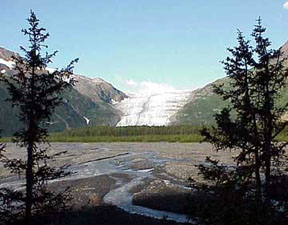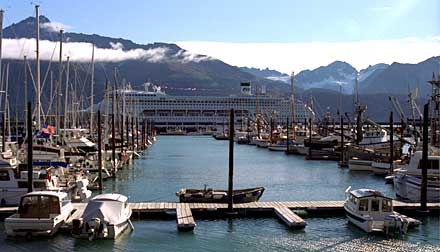The most likely starting points for summer visits to Alaska
are Anchorage,Seward, Juneau or Fairbanks. Major air carriers
fly in to Anchorage, Juneau and Fairbanks. Cruise ships make
stops in Juneau and in Seward.
Many places in Alaska are accessible only by air or water.
The state capital, Juneau, is one of those. There's been talk in the past of
running a highway into British Columbia to connect Juneau
to the North American road system but, in the meantime, the
choices come down to airline, cruise ship or the Alaska State
Ferry. As of 2007, Alaska had just under 15,000 miles of roads.
 Anchorage
and Fairbanks can be reached by road, but it's a long drive
from the Lower 48 states or from the urban centers of Canada.
The smaller communities of Seward,
Homer, Talkeetna,
Valdez, Skagway and Haines are on the road system, as is the
entrance to Denali National Park.
Anchorage
and Fairbanks can be reached by road, but it's a long drive
from the Lower 48 states or from the urban centers of Canada.
The smaller communities of Seward,
Homer, Talkeetna,
Valdez, Skagway and Haines are on the road system, as is the
entrance to Denali National Park.
Visitors arriving in Anchorage or Fairbanks will find it
most convenient to rent a car or motorhome for their Alaskan
vacation. Road conditions, in general, are good. The highway
between Anchorage and Seward has been improved in recent years,
with a number of three-lane passing areas, and it is one of
the most spectacular drives in North America. The 126-mile
trip can be easily made in three hours, though frequent stops
to admire the views may make it take longer. The first 40
miles of the trip between Anchorage and Denali National Park
is on a four-lane highway, with the remainder on a good, two-lane
highway.
The Aleutian Islands, western, northern and much of Southeast
Alaska are off the road system. Homer, in Southcentral Alaska,
is as far west as it is possible to travel on the North American
road system. Among the places that can not be reached by road
are the Gold Rush mining town of Nome, which is better known
today as the terminus of the "Last Great Race,"
the Iditarod; Barrow on the North
Slope; and the Southeast Alaskan communities of Ketchikan
and Sitka.
Photo above left is of Exit Glacier near Seward. Trails
allow visitors to approach the glacier's face.

